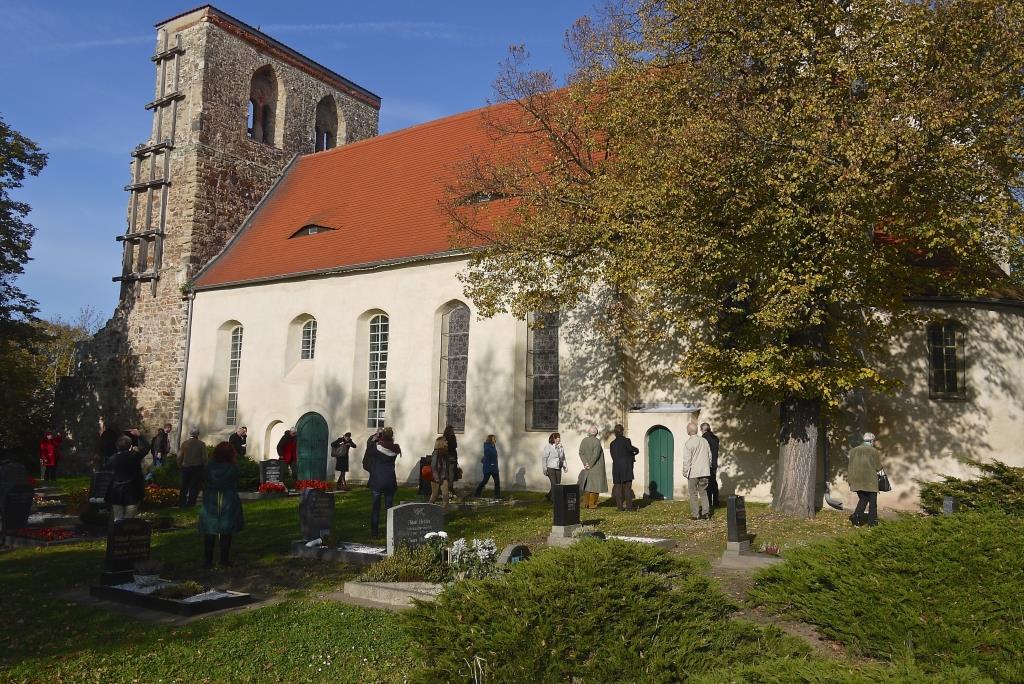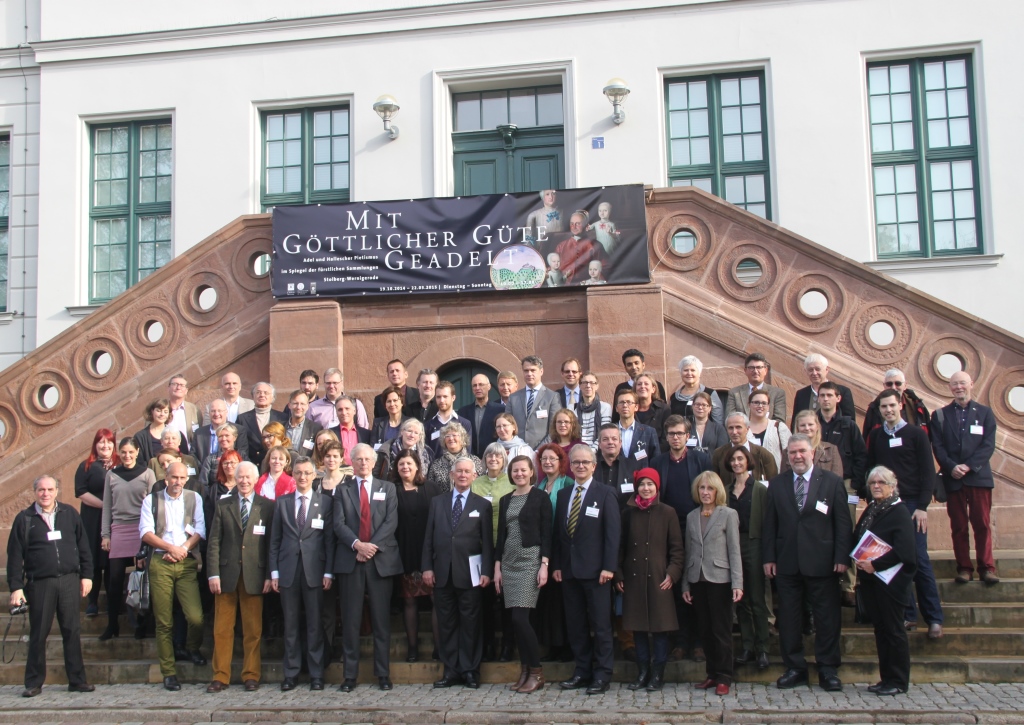Efforts of the whole of society are needed to preserve village churches in Europe!
Impressions of the second international conference on the preservation of the rural religious heritage in Europe in the church of St. Moritz and the Francke Foundations, Halle (Saale) Germany, 29th October – 1st November 2014, by Dr. Uwe Otzen and Angus Fowler.

Site Visits led by Dipl.-Ing. Gotthard Voss. Photo: Ola Wetterberg.
The European association Future for Religious Heritage (FRH) organized its second international conference from 29th October to 1st November 2014 in the Francke Foundations in Halle (Saale) in Germany with thematic, organizational and financial support from two of its founding members, the Foerderkreise Alte Kirchen e.V. (Marburg) and Berlin-Brandenburg e.V., and the Association of Societies for Church Building in Sachsen-Anhalt, the Foundation Entschlossene Kirchen in the Church District of Zerbst, the Landesheimatbund Sachsen-Anhalt, the Academy of the Roman-Catholic Diocese of Magdeburg, the German Foundation for the Protection of Historic Monuments, the Federal State of Sachsen-Anhalt, the Handel City Halle and the British Headley Trust. Theme was the preservation and use of the rural religious heritage in Europe.
The historic important Baroque Francke Foundations in Halle, the Gothic Church of St. Moritz, the late Gothic Market Church of St. Mary and four Romanesque village churches near Halle provided a wonderful framework for the conference which was particularly concerned with the fate of village churches threatened by oblivion and decay. Over a hundred participants from the Churches, the academic world, conservation departments, societies and associations for the preservation of churches from the whole of Europe met in the Handel City Halle. Together they looked for ways by which the very rich but increasingly threatened religious-cultural heritage of Europe can in the 21st century be preserved, used and passed on to future generations and furthermore also still be seen, experienced and valued as a cultural norm.
At the beginning the organ resounded with variations on Georg Neumarks chorale „Wer nur den lieben Gott laesst walten“ in the fading evening light in the Church of St. Moritz. A good beginning! The Roman-Catholic Provost of Halle, Reinhard Hentschel, opened the festive evening with a thought from the 1st Letter of Peter 2,5 which set the tone for the conference: „In and with churches people can express that they can also give God a place in their surroundings“. In an additional word of greeting Dr. Johannes Koch, director of culture at the German Roman-Catholic Bishops’ Conference, pointed to religious heritage threatened at the moment in other parts of the world particularly in the Near East in Iraq. Angus Fowler gave a brief presentation of the current state of the rural religious heritage in Germany, where there is no mass redundancy or demolition although problems do exist. The conference itself began the next morning in the historic great Prayer and Reading Hall of the Francke Foundations and was introduced with the teaching experience of the theologian and great educationalist August Hermann Francke. The Chairman of the Curatorium of the Foundations, Prof. Dr. Helmut Obst, wished all success for the beneficial promotional work of FRH and the many associations present and that they should also take care „to preserve not only the external shell of places of worship but also their intrinsic core“. After greetings from the Federal Minister of State for Culture, Prof. Monika Gruetters, and Stephan Dorgerloh, Minister for Culture in Federal State of Sachsen-Anhalt the two-day, tightly filled and very intensive conference programme with interesting plenary, parallel and poster sessions began.
Impulse statements by major European cultural experts opened a broad discussion of basic questions such as „How can the preservation of the religious heritage get on to the political agenda in Europe?“ , „How can the values of the religious heritage be passed on to future generations?“ or „How can the rural religious heritage be seen in a broader social context?“
Two general directions of opinion emerged: One side emphasized the preservation of the respective religious foundations of the cultural heritage as a pre-condition for the further existence of the buildings. This was expressed in all the official greetings as well as contributions from Greece, Italy, Spain, Portugal, Belgium, Estonia and also Germany. The other side stressed an appropriate widening of use as a pre-condition for a sustainable safeguarding and a broad social appreciation of the cultural heritage. This was mentioned particularly in talks from England, Sweden, the Netherlands, and also Germany. The conference ended with discussion and further formulation of a conclusion. This included four major points: 1. Better publicity of the highly important and valuable European religious heritage, 2. Containing and reducing the dangers and threats to this heritage, 3. Better stress of the national and social-economic use and worth of preserving the religious heritage, and 4. Formation of an alliance of mutual responsibility throughout the whole of society for the preservation of the religious heritage.
Interesting social and cultural events took place in the evenings: The conference dinner in the fine late 19th century Stadthaus (City House) which began with a notable, vigorous and friendly greeting and introduction to the Handel City Halle by the City’s Director of Culture, Frau Dr. Marquardt, in excellent English with a slight Australian accent. We were given a brief tour of the great Market Church of St. Mary, begun 1529/30 under Albrecht of Hohenzollern, Archbishop of Magdeburg and Mainz, Luthers major adversary, followed by a wonderfull organ concert by the French-born Cantor and Organist, Irenée Peyrot, with works by Georg Friedrich Handel and his teacher F.W. Zachow on the small well-preserved choir organ of the 17th century, and then on the large organ, orginally built in the early 18th century. Works by Wilhelm Friedemann Bach were played who was cantor and organist at the church for almost twenty years, and finally a major fantasia by his father J.S. Bach who checked and approved the large organ on its completion.

Group photo outside the Francke’sche Stiftungen.
The excursion which completed the programme was prepared and guided by the very well-informed and expert, the former Chief Conservation Officer of the Federal State of Sachsen-Anhalt, Dipl.-Ing. Gotthard Voss. First stop was the Church of SS Peter, Paul and Ursula in Naundorf, a Romanesque stone building from the early 13th century. Here we were greeted by Michael Schoenheit, organist of the famous Gewandhaus in Leipzig, with variations by Johann Gottfried Walther on the chorale „Jesu, meine Freude“. On the suggestion of Mr. Voss and as a tribute to the notable international visit the local representatives present (Church Council, Mayor etc.) decided on the spot to found an association for the preservation of the church particularly of the important Romanesque portal threatened by decay. Next stop was in Osmuende the Church of St. Peter where we were greatly impressed by the outstanding restoration by the church council with the very active supporting association after considerable destruction when the large western tower collapsed. In the Church of SS Anna and Katharina in Landsberg-Guetz the restoration of the choir windows and particularly their completion through filling of missing parts by modern contemporary glass designed by the well-known artist Markus Lueperz was the climax of the repair work. The very active association provided an excellent lunch. Finally we were received with a peel of the church bells and also music for organ and flute in the Church of St. Michael in Brachstedt by the local Lutheran Pastor, representatives of the Church Council and the supporting association for the church. The rectangular west tower built of rough stone mainly in the 12th century stood majestically in the radiant blue sky of a fine warm autumn day.
At the end the conference participants were sent on their way with words from Psalm 84 „How lovely are they dwellings, Lord Sabaoth“ and a blessing for their journey and soon began their return home to all ends of Europe, the Lafoten-Islands in north Norway to Italy and from Portugal to Russia. A great and certainly a successful conference with long enduring results!
For photos, PTT presentations and further reports, please visit the Halle conference web page.
Dr. Uwe Otzen
(former Chairman of the Foerderkreis Alte Kirchen Berlin-Brandenburg e.V.)
Angus Fowler
(Committee member of the Foerderkreis Alte Kirchen e.V., Marburg, former Chairman of the Foerderkreis Alte Kirchen Berlin-Brandenburg e.V.)





Follow us: